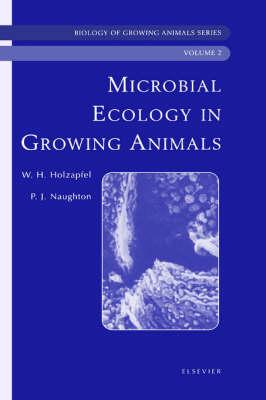Overview
The complexity of the microbial population of the animal gastro-intestinal trac has been recognised long ago. However, thus far, investigations have been limited to a few major groups, considered to be dominating, and pathogens that are detrimental and may case diseases and concomitant financial losses in the production animal. Thanks to the latest developments, including improved micriological detection and sampling techniques, and the application of molecular tools to monitor the presence of specific strains in the intestine, our knowlede has increased rapidly in recent years. In addition, new approaches towards improving and/or stabilising animal health, are addressed, with special emphasis on probiotics, and also with regard to the use selected bacterial strains as vehicles for delivery of pharmaceutically active compounds to the muscosa. The book is unique in several respects, not only by its coverage of an extremely wide area in animal gut microbiology, but also by the fact that production animals such as fish and reindeer are included. Scope and treatment of the subject matter and the kind of information that can be found in the volume:Colonisation and development (succession), and mucosal surface composition of the normal microbial population flora in the healthy animal are addressed, whilst estensive information is given on diverse and dominating bacterial populations of different animal types. Reference is also made to those microbial groups considered to be of special benefit to the health and immune protection of the (young) animal bacteria. The development and application of models of the Gastro-Intestinal tract provides a solid basis for studying gut microbial interactions, whilst molecular approaches and the us of molecular tools to monitor the presence of specific strains in the intestine is treated in a comprehensive manner.
Full Product Details
Author: Wilhelm Holzapfel , Patrick Naughton (Lecturer in Medical Microbiology, University of Ulster, UK)
Publisher: Elsevier Health Sciences
Imprint: Elsevier
Volume: 2
Dimensions:
Width: 23.40cm
, Height: 3.00cm
, Length: 15.60cm
Weight: 1.100kg
ISBN: 9780444509260
ISBN 10: 0444509267
Pages: 522
Publication Date: 15 February 2005
Audience:
Professional and scholarly
,
Professional & Vocational
Format: Hardback
Publisher's Status: Out of Print
Availability: Out of print, replaced by POD 
We will order this item for you from a manufatured on demand supplier.
Table of Contents
Preface by Series Editors Preface by Volume Editors Acknowledgements List of contributors Part I. The flora and fauna of the developing GI tract 1. Development of the digestive tract of gnotobiotic animals, by A. Bomba, R. Nemcova and S. Gancareikova 2. Metabolism and population dynamics of the intestinal microflora in the growing pig, by M. Katouli and P. Wallgren 3. Rumen protozoa in the growing domestic ruminants, by T. Michaowski 4. Microbial ecology of the digestive tract in reindeer - seasonal changes, by S.D. Mathiesen, R.I. Mackie, A. Aschfalk, E. Ringo and M.A. Sundset 5. Microbial ecology of the GI tract of the growing dog and cat, by J. Zentek 6. Molecular approaches in the study of gut micro-ecology, by A. Schwiertz and M. Blaut 7. Models of the gastro-intestinal tract to study microbial interactions, by M. Minekus Part II. Pathogenicity in developing animals 8. Adhesins and receptors for colonization by different pathotypes of Escherichia coli in calves and young pigs, by B. Nagy, I. Toth and P.Zs. Fekete 9. The farm animal as potential reservoir of antibiotic resistant bacteria in the food chain, by G. Klein and C.M.A.P. Franz 10. Pathogenesis and the GI tract of growing fish, by T.H. Birkbeck and E.Ringo 11. Modelling of salmonellosis, by P.J. Naughton and G. Grant 12. Bacterial colonisation of avian mucosal surfaces, by R.M. La Ragione, D.G. Newell and M.J. Woodward Part III. The immune response in growing animals 13. Mucosal immunity and bovine entero-mammary link: evolutionary established dialogue between antigen and arms of immune system, by M. Niemiatowski, A. Schollenberger and W. Klucinski 14. Development of the immune response in relation to bacterial disease in the growing fish , by A.E. Ellis 15. Development of lactobacilli for mucosal immunisation, by J.F.M.L. Seegers, C.E.G. Havenith, S.H.A. Kremer and P.H. Pouwels 16. The influence of the lactic acid bacteria and other resident microflora on the immune system of the growing animal, by G. Perdigon, R. Fuller and M. Medina Part IV. Probiotics and disease prevention strategies 17. Prospects of fish probiotics, by L. Gram and E. Ringo 18. Antimicrobial activity of lactic acid bacteria isolated from aquatic animals and the use of lactic acid bacteria in aquaculture, by E. Ringo, U. Schillinger and W. Holzapfel 19. Enhancement of the efficacy of probiotic microorganisms in nutrition and prevention of diseases of the young animal, by A. Bomba, R. Nemcova and D. Mudrooova 20. Strategies for the prevention of E. coli infection in the young animal, by E. Van Driessche and S. Beeckmans Index
Reviews
Author Information
Tab Content 6
Author Website:
Customer Reviews
Recent Reviews
No review item found!
Add your own review!
Countries Available
All regions
|




